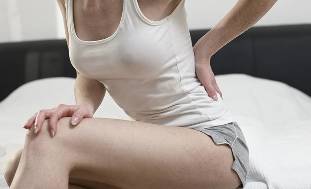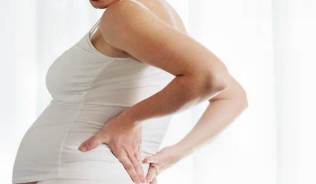Usually back pain lying down subsides or stops completely, so many patients accept such symptomatic manifestations of the usual fatigue after intense exercise. A completely different clinical picture is characterized by increased pain when the patient is resting in a horizontal position.

Often the pain is a sign of a serious disease that requires immediate treatment. Atypical symptoms, be sure to consult an expert.
Predisposing factors and causes
Doctors distinguish between two main groups of etiological factors that may influence the emergence of pain in the back, when patients are at rest. The first relates to the physiology of pain due to intensive strength training, surgery, excessive exercise, prolonged stay in a static position. The second group characterizes the development of symptoms of serious diseases of the skeletal system or the muscular and cartilaginous structures. Common causes are:
- pregnancy (II and III trimenon);
- increase in body weight;
- in the later stages of diseases of the musculoskeletal (arthritis, osteochondrosis);
- pathology of the urinary system and the reproductive system;
- malignant tumors of the internal organs;
- acute inflammatory disease of bone tissue;
- herniated discs localized in the sacral region of the spine.
The clinical picture manifested in each patient individually, as well as in the treatment of patients, which is a growing pain, where the patient lying on the back. The nature of pain and its intensity depend on the degree or the duration of the pathological processes. Characteristics of pain as follows:
- pulling, burning, sharp, dull, shooting;
- moderate, strong, weak, episodic;
- bilateral or unilateral;
- radiating to the various departments of the spine (usually the lumbar, sacral, cervical parts);
- long-term or others.
It is important to consider criteria changes in pain when you change body positions, after applying certain medications. Back pain in the supine position may depend on the time of day.
Inflammation of the urinary tract and pyelonephritis
Pyelonephritis — inflammation of the kidneys, the ascending urinary tract. Back pain when lying down back to the parent location of the kidneys. Anatomically they are located closer to the back, or under the hypochondrium. The pain caused by the expansion of the fibro-basic tissue layers of the kidney structures. Pain pyelonephritis drawing, feel, mostly during the night hours. The tendency to increase the morbidity occurs when strong shaking, deep breathing, riding a bike or riding a horse. During the study the patient reacts to the sound of the kidneys back or light jumping.
Other symptoms are:
- change in color of urine and atypical impurities (turbidity, white flakes, the mucous membrane of the component, the orange shade);
- frequent urination and pain, including cystitis (and possibly complication, inflammation of the bladder);
- an increase in body temperature (true for children up to 15 years).
Long flowing pyelonephritis can cause serious complications in all renal structures is often the cause of chronic renal failure.
Symptoms of the disease
To facilitate the occurrence of "lying" back pain can development of degenerative disc disease — pathological changes in bone and cartilage tissue of intervertebral discs of any kind. The disease is the most common dystrophic tissue changes in the axial skeleton.

Lower back pain lying on back background of osteochondrosis is associated with irritation of the nerve roots located in the spine. Pain in osteochondrosis can be the following:
- firing (sharp, long);
- deep, long-lasting, nagging;
- sharp shooting radiating the lower limbs.
The pain can intensify at night, especially when turning from side to side. The pain intensifies, and after falling asleep on a soft bed, with a sharp involuntary movements. In addition, patients reported decreased sensitivity in the back, muscle weakness, a change in the conditional reflex reactions, burning, tingling, or complete numbness.
Ankylosing spondylitis
Disease refers to special conditions that are characterized by nocturnal pain, otherwise known as ankylosing spondylitis. The disease is autoimmune in nature, occurs joints of the spine or sacroiliac joints joints.
Ankylosing spondylitis is a back-lying on back, mostly at night. Any movement to ease the patient's condition. Other symptoms are:
- limitation of joint movement;
- the stiffness of the lumbar spine;
- the curvature of the vertical axis of the spine according to the type of scoliosis;
- to reduce the growth;
- forced position of the body when back pain.
Ankylosing spondylitis can occur in patients of any age, depending on the clinical patient history, and other predisposing factors.
Ulcerative lesions of the duodenum
Peptic ulcer disease department of duodenal ulcers is another cause of back pain. The appearance of the pain of lying related to the hunger pains, when the mucous membrane is maximally exposed and subjected to damage of the gastric juice. A typical localization of the pain area of the peritoneum, but because of the anatomy of the intestine, they are able to give and back-division. Other symptoms are:
- the emergence of persistent dyspeptic disorders;
- flatulence, or bloating;
- sour belching;
- violation of the chair.
Usually after antacids, the pain subsides. The lack of appropriate treatment often leads to complications in the form of stomach or intestinal bleeding, perforation of the mucous membranes, disease of the mucous membrane of the intestine.
There are many reasons that can cause the intensity of pain during the night sleep on their backs or lying a day. Ignore such symptoms are dangerous because of the gradual progression and development of severe complications, even disability.
Treatment and prevention
The treatment begins with a thorough differential diagnosis to identify the underlying disease that determines the appearance of the soreness.
During treatment it is necessary to change the body position during sleep. You get this hard, orthopedic mattress, pillow, padding on the back. During drug treatment, it is recommended to do physical therapy, massage. An active lifestyle is an important part of a successful recovery.
To relieve pain requires the appointment of analgesics (ointments, systemic drugs, balsams), a variety of lotions, compresses therapeutic compositions. Often used in recipes of traditional medicine.

The prognosis of "lying" pain depends entirely on the nature of the pathology, the degree of development of dystrophic processes, as well as the original cause. Generally, early diagnosis and compliance with all medical recommendations significant improvement in patient quality of life, lower risk of disability.





































